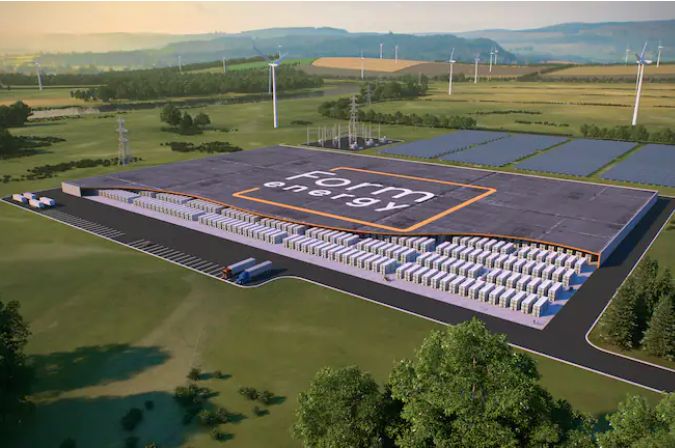Iron-air batteries: Huge green-energy breakthrough, or just a lot of hype?
from Washington Post
Opinion by David Von Drehle
The most important news story of 1903 received modest coverage, and it wasn’t very accurate.
Two brothers from Dayton, Ohio, conducted four machine-powered, heavier-than-air flights under human control on a single day in December. The Virginian-Pilot newspaper in Norfolk, not far from the Kitty Hawk, N.C., testing ground, ran an exaggerated account of the Wright Brothers’ triumph — but in Dayton, a hometown paper refused to mention it. “Man will never fly,” a local editor harrumphed (perhaps apocryphally). “And if he does, he won’t be from Dayton.”
Another possible milestone of technology passed quietly not long ago. It might be the beginning of the end for fossil fuels and the key to reaching the goal of a green power grid. If so, it will certainly be among the most important stories of the year — bigger than space tourism, bigger than the Arizona election audit, bigger than the discovery that the amazing Simone Biles is human, not a god.
One caveat: Very few engineering breakthroughs change the world. Most end up being less than meets the eye. That said, let’s have a look.
A Boston-area company, Form Energy, announced recently that it has created a battery prototype that stores large amounts of power and releases it not over hours, but over more than four days. And that isn’t the best part. The battery’s active ingredients are iron and oxygen, both incredibly plentiful here on God’s green Earth — and therefore reliably cheap.
Put the two facts together, and you arrive at a sort of tipping point for green energy: reliable power from renewable sources at less than $20 per kilowatt-hour.

Some readers of this column will be experts in battery technology, and for them it may be useful to note that the history of battery engineering is littered with duds that were heavy on hype and big on disappointment — including earlier iron-air cell.
Other readers (and this columnist) are not experts. For them, it may be helpful to explain why the right storage battery could be so crucial to a climate-friendly energy future — whether it is this battery or a better one down the road.
Use of renewable energy sources, especially wind and solar, has grown dramatically over the past generation, but renewables still comprise a small slice of the total U.S. energy budget. Storage is holding them back. People need electricity all the time, not just when the sun shines or the wind blows.
The cost of storage is critical. Utilities will change sources if the price is right. Coal used to be king in the power sector, but cheap natural gas has cut coal’s share of the energy diet in half since 2005. Renewables will never meet their potential until battery storage for green power is cost-competitive.
Say, $20 or less.
Form Energy is no seat-of-the-pants outfit. Its founders include Mateo Jaramillo, former head of battery development for Tesla, and MIT professor Yet-Ming Chiang, among the world’s foremost battery scientists. Investors include Microsoft co-founder Bill Gates, Amazon founder and Post owner Jeff Bezos, the iron and steel colossus ArcelorMittal, and MIT’s The Engine, a strategic fund aimed at long-term solutions to big problems.
At Tesla, Jaramillo understood that electric vehicles are a limited solution to greenhouse emissions as long as batteries are charged by burning fossil fuels. His new venture looked at past disappointments in battery technology to find the most promising for a new approach.
Small pellets of iron — among the five most plentiful elements in the Earth’s crust — release energy when exposed to oxygen. By reversing the process of oxidation (commonly known as rusting), the battery stores energy. Repeatedly rusting and unrusting the iron allows the cell to charge and discharge electricity.
According to its announcement, Form Energy has the process working well under lab conditions. The next step is a one-megawatt pilot project with an electric utility in Minnesota, set to begin after the project battery’s expected completion in late 2023. If successful, the collaboration could lead to a larger project to power part of the utility’s system.
Then we’ll begin to know just how important this is.
And wait — as the old TV ads liked to say — there’s more. This battery might be worthy of a Nobel Peace Prize, too. The best rechargeable batteries currently rely on lithium as their vital ingredient, a rare earth element roughly 2,000 times less plentiful than iron. Global security experts have talked about a coming “war” for lithium as the rare element powers the future.
If iron can take over large-scale storage from lithium, it will cool the flame under that kettle. The United States can aim for self-sufficiency in storage batteries. And this truly will be a blockbuster story of 2021.
CORRECTION
An earlier version of this column was briefly amended to state, incorrectly, the cost of battery storage in terms of megawatts. That cost is properly measured in kilowatt hours. It also incorrectly described lithium as a “rare earth mineral”; it is an element. And it mischaracterized a collaboration between Form Energy and an electric utility in Minnesota. Form Energy is working with the utility on a one-megawatt pilot project to begin after the project battery’s expected completion in late 2023; if successful, the collaboration could lead to a larger project to power a portion of the utility’s system. The project will not power the utility’s entire system. This version has been corrected.
Read more:
Mark P. Coombs: In Virginia, climate progress and preservation can work together
Thea Riofrancos and Mark Paul: Biden risks botching a key chance to fight climate change
The Post’s View: Biden promises big on climate change. Delivering will be much harder.
